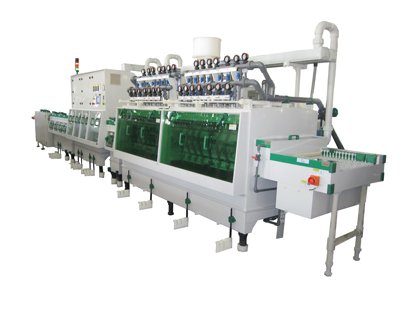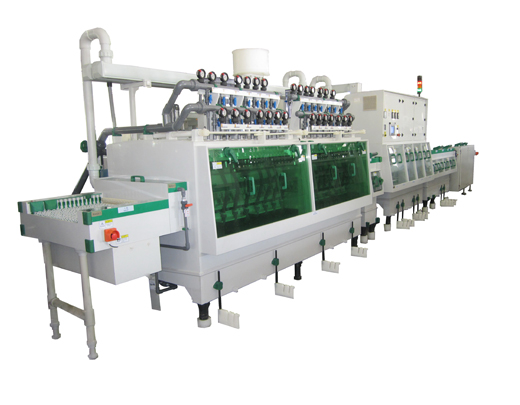Generally, the developing machine is composed of power system, developing solution tank and spray pipe, water rinsing tank, extrusion (water) roller, gluing tank, etc. a good PCB developing machine should also have timer and temperature control system.
① Transmission system: It is the driving device to guide the operation of PCB. The motor drives the transfer roller to rotate through the worm gear or sprocket chain, and drives the PCB through each working link of the developer through the counter pressing rubber roller.
② Developing system: During the PCB developing, the photosensitive layer in the blank part of the printed circuit board is rapidly dissolved through uniform and continuous spraying of circulating developing solution. Some developers are also brushed with brush rollers to accelerate this dissolution.In order to ensure that the developer works under constant conditions, this part also has a heater and cooler, which can automatically adjust the temperature.The liquid solution is automatically circulated and filtered to ensure the uniform concentration and temperature everywhere.
③ Rinsing system: Two groups of spray pipes spray clean water to the front and back of the PCB to remove the development products and excess developer solution attached to the pcb board, and squeeze the water on the PCB through the extrusion roller.It has the function of secondary water rinsing.④ Gluing system: The main function is to apply a layer of uniform protective glue on the developed PCB. Many developing machines and tools are equipped with automatic cleaning function of coating rollers.⑤ Drying system: It is composed of air supply pipe and rubber roller. The PCB is dried quickly through blowing and heating, and finally the pcb is sent out.
Adjustment of developing machine (working part)
1. Adjust the pressure between the cots according to the thickness range of the PCB to ensure that there is no liquid channeling or small liquid channeling, and in the developing solution/rinsing, rinsing/protective glue and protective glue / drying sections, ensure the plate is clean when it comes out of two rubber rollers.
① Adjust the pressure between the gluing rollers to adjust the thickness of the gluing, so as to ensure that the hardness of the gluing roller is suitable for the printed board. Under the condition of ensuring the above requirements, the pressure shall be as small as possible, if the pressure is too large, the load of the pcb developing machine will be increased, and the pcb plate will be easy to be stuck.
② The development tolerance of plates with different thickness must be guaranteed.
2. Adjustment of brushing wheel pressure
① The brush shall be clean, flexible, free of burrsing and scratching the pcb.
② Adjust the pressure according to the test results to ensure dot reduction.
③ The pressure should be as small as possible, otherwise the pcb plate is difficult to pass under high pressure, and the field and small dot are damaged.
④ The rotation direction of the brush wheel is opposite to the forward direction of the pcb plate, which is conducive to the developing effect.
⑤ Adjust according to the plate thickness range to ensure the development tolerance.
3. Adjustment of water pressure for PCB plate rinsing
Feel the water pressure with your hand, the strong pressure to ensure sufficient rinsing.
Parameter setting of the PCB developing machine
(1) Temperature:The temperature distribution shall be uniform, the four point error of PS plate shall not exceed 1 ℃, and that of PCB developing machine shall not exceed 0.5 ℃.
(2) Development time: control the development time by adjusting the printing speed.
(3) Developer solution supplement (startup supplement, static supplement and dynamic supplement): During the developing process, the PCB developing machine will gradually lose and reduce the developing performance, so it needs to be supplemented in time. The supplement setting is according to the plate and developer solution type.
(4) Speed of brushing wheel: Set the speed according to the actual test effect to ensure the field density and the normal restoration of small dots.
(5) Water volume and water pressure for plate rinsing (front and back): ensure sufficient water rinsing
(6) Drying temperature: 50-70 ℃
Maintenance the PCB developing machine depending on the drying condition and printing effect.
1.Ensure the smooth circulation of developer solution, glue and rinsing water without blockage;
2.Replace the developer solution regularly and clean the developing machine at the same time (generally once a day);
3.Replace the filter element regularly, generally once a week (100u filter element is recommended);
4.Replace the protective glue regularly and clean the protective glue system (once a day is recommended);
5.Scrub the rubber roller every day (clean soft cloth may be stained with developer);
6.Clean the rubber roller regularly and thoroughly to ensure uniform pressure between them (once a week);
7.Clean the guide rail of heating section regularly (once a week);
8.The whole machine shall be cleaned, and there shall be no developer solution or other chemical agents on the surface of the pcb developing machine.











